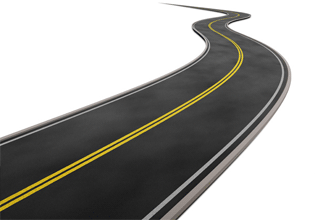|
| Road Marking |
| |
 |
Road marking is any kind of device or material that is used on a road surface in order to convey official information. They can also be applied in other facilities used by vehicles to mark parking spaces or designate areas for other uses.
Road markings are used on paved roadways to provide guidance and information to drivers and pedestrians. Uniformity of the markings is an important factor in minimizing confusion and uncertainty about their meaning, and efforts exist to standardize such markings across borders.
They can be used to delineate traffic lanes, inform motorists and pedestrians or serve as noise generators when run across a road, or attempt to wake a sleeping driver when installed in the shoulders of a road. Road marking can also indicate regulation for parking and stopping.
There is continuous effort by us to improve the road marking system, and technological breakthroughs include adding reflectivity, increasing longevity, and lowering installation cost. |
|
 |
|
| |
| Procedure |
SURFACE PREPARATION
- Asphalt surface preparation must be dry, free from dust, dirt, grease and loose materials.
- Concrete surface must be dry, clean, free from laitance and dust.
- Concrete surface previously treated wih curing compound must be treated with a concrete primer sealer before application.
METHOD OF APPLICATION
Thermoplastic markings are applied using specially designed vehicles. The thermoplastic mix is heated in trucks to about 200 °C (400 °F) before being fed to the application apparatus. This is often a screed box or ribbon gun. Immediately after the thermoplastic has been applied, glass beads are laid onto the hot material so that they embed before the plastic hardens. These beads provide initial retro-reflection. As the marking wears during use and the initial beads are lost, the beads mixed with the binder are uncovered, providing long term reflectivity. Most thermoplastic is produced in white and yellow colors, but other colors such as red may also be produced.
|
|
|
| |
PROPERTIES
A high quality Thermoplastic Road Marking powder conforming to BS 3262 insisting of Aliphatic Hydrocarbon Resin plasticized with mineral oil, heat stable pigment, 20% reflectorized pre mixed glass beads, calcium carbonate extenders and extra white calcite aggregates. ROMAC White & Yellow are easy to melt and apply on all asphalt and concrete surfaces using screed, extrusion and spray machines to form a highly durable marking with excellent adhesion, colour fastness, skid resistance and light reflectivity. |
|
| |
| Pysicals Properties (Result) |
| Colour |
WHITE |
YELLOW |
| Specific Gravity |
|
2.00 |
| Softening Point |
99°C - 105°C |
101°C - 106°C |
| Flash Point |
Greater than 240°C |
Greater than 240°C |
| Drying Time |
3 min at 32°C |
3 min at 32°C |
| Flow Resistance |
Less than 4% |
Less than 4% |
| Aggregate Settlement |
None ( At 2hrs, at 200°C ) |
None ( At 2hrs, at 200°C ) |
| Skid Resistance |
Greater than 60 |
Greater than 60 |
| Luminance Factor |
Greater than 75 |
Greater than 50 |
|
|
| |
PACKING
25Ks bag. Each container of Thermoplastic material will be clearly and indelibly marked with the following information.
1. The name and identification of manufacturer – ROMAC ASPHALT
2. Batch number
3. Date of manufacture
4. Colour – White / Yellow
5. Max heating and application temprature along with instructions.
SHELF LIFE
12 months from the date of manufacture. (Material should be stored in a cool and dry place away from moisture ). |
 |
|
| |
|
| |
|
| © Copyright 2011 : www.autosignindustries.com |
All right's Reserved by Autosignindustries |
|
Powered by :  |






